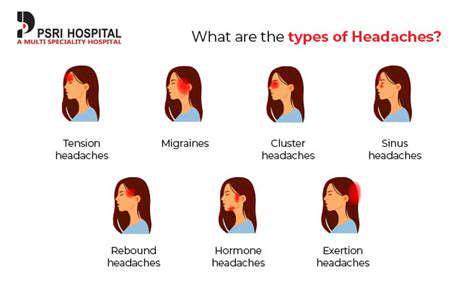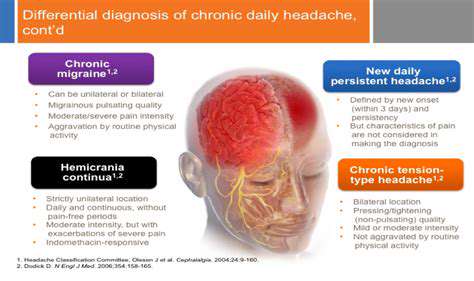Types of Severe Headaches

Understanding Primary Headaches
Primary headaches are defined as headaches that occur independently and are not caused by underlying medical conditions. They include types like tension headaches, migraines, and cluster headaches. These headaches can significantly impact an individual's quality of life due to their frequency and intensity. It’s essential to recognize the distinct characteristics of each type to manage symptoms effectively.
Tension headaches often feel like a tight band around the head and are usually triggered by stress, fatigue, or muscle strain. Conversely, migraines can cause intense, throbbing pain, often accompanied by nausea or sensitivity to light and sound. Moreover, cluster headaches are known for their debilitating nature, appearing in cyclical patterns and often waking sufferers from sleep.
Effective management of primary headaches can include lifestyle modifications such as adequate hydration, regular exercise, and good sleep hygiene. Additionally, over-the-counter medications may provide relief for mild to moderate cases. In some instances, seeking professional help might be necessary for specific treatments or medications.
Keeping a headache diary can help identify triggers and patterns, providing valuable information for healthcare providers. Understanding these aspects of primary headaches is crucial for timely intervention and treatment.
Education on headache types and symptoms is key—self-awareness is vital in managing and reducing the occurrence of severe headaches.
Recognizing Secondary Headaches
Secondary headaches occur due to underlying health issues, and they can signal potentially serious conditions. Recognizing secondary headaches early on can help prevent complications and ensure timely treatment. These headaches may be linked to infections, head injuries, or neurological disorders, necessitating thorough evaluation.
Common causes of secondary headaches include sinusitis, which causes pressure and pain in the facial area, and hypertension, where elevated blood pressure can lead to chronic headache issues. Other serious causes might include a brain tumor or aneurysm, which require immediate medical attention.
Symptoms that differentiate secondary headaches from primary ones include sudden onset, a change in headache pattern, or accompanying neurological symptoms like confusion or vision changes. It’s critical to seek medical advice if headaches are accompanied by these alarming signs.
Diagnostic evaluations such as imaging scans and blood tests can aid in identifying underlying issues causing secondary headaches. Treatment will depend on the root cause but may involve prescription medications or more specific interventions.
Potential Health Conditions Indicated by Severe Headaches

Understanding the Symptoms Associated with Severe Headaches
Severe headaches can manifest in various forms, including migraines, tension-type headaches, and cluster headaches. Each type exhibits unique characteristics and accompanying symptoms. It is essential to recognize these symptoms to seek appropriate medical attention.
Migraines, often characterized by intense throbbing pain, can also come with nausea, vomiting, and heightened sensitivity to light and sound. These additional symptoms can significantly affect a person's ability to function during an episode.
Tension-type headaches are typically associated with a tight band-like sensation around the head, causing discomfort rather than severe pain. Understanding the nuances of each headache type can help in identifying the underlying causes.
Cluster headaches, although less common, are excruciating and occur in cyclical patterns. They can happen multiple times a day during a cluster period, severely impacting an individual's daily life.
Recognizing the frequency, duration, and intensity of headaches is vital for effective diagnosis and treatment options.
Possible Underlying Medical Conditions
Severe headaches can be indicative of various underlying health issues. These conditions may range from less serious to more serious concerns that require urgent attention. Understanding the potential implications can empower individuals to seek timely medical advice.
For instance, headaches can signify the presence of a neurological disorder, such as a brain tumor, which may produce additional symptoms like vision changes or seizures. Early diagnosis is crucial for better outcomes in such cases.
Hypertension or significantly elevated blood pressure can also lead to severe headaches, often referred to as hypertensive headaches. Monitoring blood pressure regularly is essential, especially for individuals diagnosed with high blood pressure.
Other conditions, such as sinus infections or meningitis, can present with symptoms similar to severe headaches, emphasizing the importance of medical evaluation when headaches become more pronounced.
Additionally, lifestyle factors, including stress, dehydration, and poor sleep, can exacerbate headaches, making a holistic approach to health crucial. Recognizing these factors is essential for managing headache occurrences.
When to Seek Professional Medical Help
Knowing when to seek medical intervention for severe headaches is crucial for maintaining overall health. If headaches become more frequent or severe, it may be time to consult a healthcare professional. Awareness of warning signs can save lives.
Red flags to watch out for include sudden severe headaches that differ from previous experiences, headaches following a head injury, or those that occur with neurological symptoms such as confusion or difficulty speaking.
Patients should also consider reaching out if headaches are accompanied by visual disturbances, persistent vomiting, or fever, as these can indicate a more serious issue.
Regular medical check-ups can help in the early detection of potential health concerns linked to severe headaches. Keeping a headache diary can assist healthcare providers in identifying patterns and underlying causes more effectively.
Ultimately, proactive health management and awareness are vital in addressing and alleviating severe headache issues effectively.
When to Seek Medical Attention
Understanding the Types of Severe Headaches
Severe headaches can manifest in various forms, each indicating different underlying health issues. Common types include tension headaches, migraines, and cluster headaches. Understanding the specific type you are experiencing is crucial for determining the appropriate course of action.
Tension headaches often produce a dull, aching sensation on both sides of the head and can be accompanied by a tightness in the neck and shoulders. These headaches can result from stress, anxiety, or muscle tension.
Migraines, on the other hand, are characterized by intense, throbbing pain, usually on one side of the head. They may be accompanied by nausea, vomiting, and sensitivity to light and sound. Migraines can last from a few hours to several days, affecting daily functioning.
Cluster headaches are less common but extremely painful, often occurring in cyclical patterns or clusters. They can cause severe pain around one eye and may lead to swelling or redness in the affected area. Recognizing these types can help in seeking appropriate help.
Common Symptoms Accompanying Severe Headaches
When experiencing severe headaches, it is essential to pay attention to accompanying symptoms. Some symptoms may be indicative of a more serious condition and necessitate prompt medical attention.
Visual disturbances, such as blurred vision or sudden changes in eyesight, can signify a neurological issue that requires evaluation. Similarly, experiencing confusion, difficulty speaking, or coordination problems should be taken seriously.
Physical symptoms like fever, stiff neck, or a rash can also indicate a serious infection or condition, such as meningitis. These symptoms should not be overlooked, and immediate medical consultation is advised.
Additionally, headaches triggered by sudden exertion or those that come on suddenly and severely should be treated as emergencies. Understanding the complete symptom picture can provide valuable information to healthcare providers.
When to Visit a Healthcare Professional
Knowing when to seek medical attention for severe headaches is essential in managing potential health risks. If you experience headaches that are significantly different from your usual pattern, it’s important to consult a healthcare professional.
Consider visiting a doctor if you experience a severe headache alongside symptoms such as confusion, seizures, or a serious headache following head trauma. These could be signs of a serious condition that warrants immediate investigation.
Furthermore, if your headaches persist despite over-the-counter medications or worsen over time, it is advisable to seek a specialist's advice. Progressive headaches could signal an underlying health issue that requires targeted treatment.
Finally, individuals with a history of headaches that suddenly change in frequency or severity should also consult their healthcare provider, as this could indicate a need for further evaluation and management options.